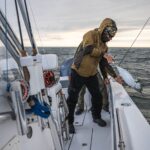
Albies Win in North Carolina: New Guardrail Management Rule Approved
After years of data pouring in from The Albie Project, advocacy, persistence, and support from
There is good reason why so many fish and wildlife migrate to the Northeast in their annual migrations—the smorgasbord of forage. Sand eels, mackerel, halfbeaks, pogies, river herring, and other forage are all essential, and every angler has their theories about which one drives the best fishing. Arguably, Atlantic herring are atop that list for many of our favorite fisheries. A suite of scientific literature exists on the important role that Atlantic herring play in the diets and wellbeing of key predators, such as bluefin tuna and other species. The fat content and rich oils found in herring is much more nutritionally dense than other species. Unfortunately, this critical forage species is struggling.
Atlantic herring was subject to years of chronic overfishing, remains overfished at just 21% of its target biomass, and is not showing promising signs towards rebuilding. To add to that, in spring 2022, a Federal Judge struck down the New England Fishery Management Council’s Inshore Midwater Trawl Restricted Area, which established a 12 and 20 nautical mile buffer zone off the New England and Cape Cod coastlines, respectively. That action involved hundreds of concerned stakeholders from the commercial and recreational fishing communities and eco-tourism businesses who saw the level of impact and ecological harm that followed MWT fishing in these inshore waters. Right now, and fortunately, the NEFMC is the early stages of developing Amendment 10, a process which could improve herring management by taking into account user conflicts, river herring and shad bycatch, and optimum yield (how to manage the herring resource to provide the overall greatest benefit to the nation and not just in respect to maximizing yield through commercial quotas). Amendment 10 could restore similar protections to the previous buffer and be developed in a more durable manner to withstand another potential legal challenge.

We wrote a more in-depth blog about the Court’s decision last summer and the Council’s interest in revisiting some sort of spatial management scheme, so take a look HERE. Just understand that despite unified support for inshore protections from a diverse public and council, the Court threw out the MWT buffer zone because the reliance on localized depletion was “arbitrary and capricious” and lacked scientific evidence. From our stand point, this is a perfect example for precautionary management in light of inadequate data, but the Judge did not share our perspective.
It’s hard to describe just how effective, efficient, and, at times, indiscriminate MWT fishing gear can be. The worst offenders are the pair trawlers—two 80+ foot industrial fishing vessels towing a massive, football-sized fine-meshed net capable of removing millions of herring per day. Amendment 8 sought to exclude MWT gear from inshore areas, because it’s the predominant gear in the herring fishery (>70%) and the intense, pulse fishing pressure clearly can remove vast amounts of the forage base in a short period of time and can create conflicts for other user groups. Incidental catch is another major issue, particularly for river herring and shad but also for other economically and culturally important fisheries.
The volume of river herring and shad that the MWT fleet catches is astonishing. The Council and NOAA Fisheries established a catch cap system to estimate and limit river herring and shad catch (landings and discards) within the herring and mackerel fisheries. However, this program is not biologically based (the caps DO NOT scale with herring biomass or quotas) and has challenges due to few observer days at sea and funding limitations. Get ready to be shocked; in 2024, the Herring Catch Caps are:

That means that the herring and mackerel fisheries can catch nearly hundreds of thousands of pounds of river herring and shad before more restrictive trip limits (2,000 lbs for the remainder of the year) are triggered for the specific catch cap area. Up and down the coast, river herring runs are failing, shadows of their historic numbers, using millions of public dollars for funding restoration efforts, and recreational and commercial fisheries are subject to strict harvest prohibitions. Yet, the herring (and mackerel) fishery is permitted to incidentally catch more than three million individual river herring (avg. river herring weight [3.9 oz] applied to the total catch cap volume). This is astonishing. At the very least, you’d think these caps would scale down with diminished quotas.
Based on a recent scientific paper, we know that there are some River Herring Bycatch Hot Spots. Using new genetic analyses and available fisheries data collection programs, the Reid et al paper was able to model bycatch rates for regional populations of river herring and identify which populations are most susceptible to bycatch in and around Block Island. Among other things, the paper found, there are specific stocks of river herring experiencing higher rates of bycatch and “Our results suggest that these restrictions [MWT buffer zone] could have conservation benefits for southern New England and Mid-Atlantic alewife.” Additionally, a new stock assessment for river herring is set to be published early this summer, which should shed additional insight on this species’ demise and may provide justifications for new management programs.
Thanks to many rightfully concerned council members and a strong stakeholder base, the NEFMC initiated scoping for Amendment 10 to, “address spatial and temporal allocation and management of Atlantic herring at the management unit level to minimize user conflicts, contribute to optimum yield and support rebuilding of the resource. The Council is also proposing to take action to enhance river herring (alewife and blueback herring) and shad (American shad and hickory shad) avoidance and other catch reduction measures to better support ongoing coastwide restoration efforts for those species.”
For the NEFMC’s full Problem Statement and background on the herring fishery and management, please review the Atlantic Herring Amendment 10 Scoping Document.
What’s Next:
It’s time to attend meetings and send some emails! It is crucial that you help shape this management action by sharing your experiences about this fishery and perspectives about how it should be managed moving forward. The NEFMC has scheduled six public scoping meetings in March and April to gather this input. From there, the Herring Plan Development Team will review all that input, provide the Council with a summary of scoping comments (likely June), and then begin developing alternatives for Amendment 10 (throughout the summer and fall). Here are the scheduled public scoping meetings:
If you cannot attend one of these meetings, you can still provide input to the council via email before the April 30th deadline!
What Info is the Council Looking For?
Now, just remember that Amendment 10 is still in its VERY early stages, so the Council is hoping to gather preliminary information to develop draft alternatives. The scoping stage is a critically important time to shape a management action—so, your input here will be very influential. Another important consideration is to not be complacent with this management action just because herring quotas and effort are comparatively low right now. The herring resource will hopefully rebuild and become abundant once again, and we all want to ensure the management of the directed fishery (particularly the MWT fleet) improves to reduce the impact it has on other herring user-groups and river herring stocks while providing the greatest overall benefit to the United States with the herring resource.
Some of the questions the Council is explicitly considering include:
User Conflict Survey
While not formally part of the Council’s process, there is a public survey out to demonstrate where and when user-conflicts with the herring fishery occur. If you have 5 minutes, your participation in this survey will further assist with Amendment 10 development and progress. A few tips: to drop a location of past conflicts with the commercial herring fishery, you will need to zoom in; I found it helpful to open the map into full screen; be sure to fill out the survey responses for each conflict report; you can add additional conflict reports by clicking (+) below “Interactions with the Commercial Herring Fleet.” Any and all information will be useful, so don’t hold back!
In the coming weeks, we’ll provide some additional context for how we’re thinking about these scoping questions. However, due to the importance of user conflict and Optimum Yield in Amendment 10, we (and the New England Fishery Management Council) want to hear from YOU about your experiences with this fishery. Whether you’ve been catching Giants off Jefferies and the MWT fleet shut down a bite, or you were striper fishing off the backside only to see a set of pair trawlers tow right off your stern, we all need to document these conflicts—and it doesn’t matter if it was this past fall or 10 years ago. It is all relevant. Also, for the Optimum Yield piece of this action, it’s important to show how a healthy and abundant herring population, or lack thereof, impacts your businesses or time on the water. OY is a pretty nebulous concept, but it can be used to account for the tangential aspects of a fishery—i.e. stakeholders other than the directed commercial fishery or for the ecological, forage considerations with other marine fish or mammals.
Be sure to stay on the lookout for more materials from the ASGA team and get out to these upcoming meetings, fill out the survey, and send the New England Fishery Management Council emails! Herring need your help, and now is the time to stand up for this critical forage species for New England and Mid-Atlantic ecosystems and so many of our favorite fisheries.

After years of data pouring in from The Albie Project, advocacy, persistence, and support from

This morning, the Connecticut Environment Committee held a hearing on House Bill 6248, a bill

Photo Credit: A striper released in Connecticut waters, courtesy of Mike Querfeld. Connecticut House Bill 6248 (2025

Feature Photo Credit: Rex Messing and the SIMMS team fishing with Captain Jaime Boyle Albie
We rely on our members and donations to keep fighting for a sustainable tomorrow in marine conservation.
GIVE THE GIFT OF FISHERIES CONSERVATION THIS HOLIDAY SEASON. SHOP ASGA GOODS THAT FUND FISHERIES RESEARCH & ADVOCACY CAMPAIGNS
JOIN ASGA IN CALLING FOR CRITICAL MANAGEMENT ACTION AFTER YEARS OF SPAWN FAILURES & POOR MANAGEMENT.
By using this website, you agree to our use of cookies. We use cookies to provide you with a great experience and to help our website run effectively. To learn more, please review our privacy policy.
One Response
Great work folks, your hard work is helping. I’ll send in a note ASAP.